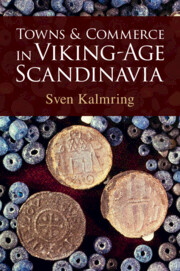Book contents
- Towns and Commerce in Viking-Age Scandinavia
- Additional material
- Towns and Commerce in Viking-Age Scandinavia
- Copyright page
- Epigraph
- Contents
- Plates
- Figures
- Maps
- Acknowledgements
- Abbreviations
- Maps
- 1 Introduction
- 2 The Viking-Age Town
- 3 The Viking World
- 4 Cult, Jurisdiction and Markets
- 5 Local Society and Viking-Age Towns
- 6 An Urbanisation Based on Harbours
- 7 Jurisdiction and Taxes
- 8 Free Trade within Narrow Boundaries
- 9 Special Economic Zones of Their Time
- 10 Development after the Inception Phase
- 11 Discussion: Hedeby’s Abandonment and the Foundation of Slesvig
- 12 Summary and Conclusions
- References
- Index
- Plate Section
8 - Free Trade within Narrow Boundaries
Published online by Cambridge University Press: 04 January 2024
- Towns and Commerce in Viking-Age Scandinavia
- Additional material
- Towns and Commerce in Viking-Age Scandinavia
- Copyright page
- Epigraph
- Contents
- Plates
- Figures
- Maps
- Acknowledgements
- Abbreviations
- Maps
- 1 Introduction
- 2 The Viking-Age Town
- 3 The Viking World
- 4 Cult, Jurisdiction and Markets
- 5 Local Society and Viking-Age Towns
- 6 An Urbanisation Based on Harbours
- 7 Jurisdiction and Taxes
- 8 Free Trade within Narrow Boundaries
- 9 Special Economic Zones of Their Time
- 10 Development after the Inception Phase
- 11 Discussion: Hedeby’s Abandonment and the Foundation of Slesvig
- 12 Summary and Conclusions
- References
- Index
- Plate Section
Summary
As discussed in previous chapters, the spatial exclusion of Viking-age towns from the surrounding rural societies can be complemented by strong arguments for a separate jurisdiction enforced by the king’s reeve, with laws distinctly different from the provincial laws, as reflected in the later high medieval landskapslagar. This can be demonstrated both archaeologically through evidence of custom boundaries and historically through suggested analogies with contemporary continental and Anglo-Saxon trade legislation as well as from the substratum of later Scandinavian law codes. During this period, not only would the royal officials of merchant towns all over Europe have been responsible for defence issues and judicial matters but their primary responsibility would have been the collection of customs duties for their royal patrons. It was the kings who, acting in the background, purposely granted space for international trade in their realms and provided the compulsory judicial and administrative framework. However, as will be demonstrated in the following, this space provided for free trade in Viking-age towns was at the same time a very strictly restricted one.
- Type
- Chapter
- Information
- Towns and Commerce in Viking-Age Scandinavia , pp. 105 - 122Publisher: Cambridge University PressPrint publication year: 2024

